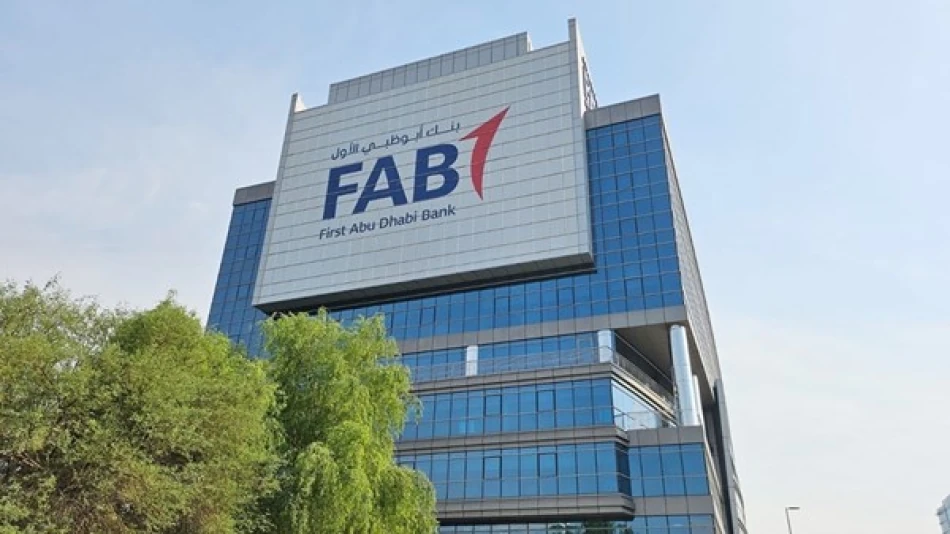
Abu Dhabi First Bank's Soaring Midyear Profits Exceed 10 Billion Dirhams for the First Time
First Abu Dhabi Bank Breaks Records with 26% Profit Surge, Signaling UAE's Banking Dominance
First Abu Dhabi Bank (FAB) has delivered a standout performance in the first half of 2025, with net profits soaring 26% to AED 10.63 billion—the first time the bank has crossed the AED 10 billion threshold in a six-month period. The results underscore the UAE's position as a regional financial powerhouse and highlight how Gulf banks are capitalizing on higher interest rates and robust economic activity.
Financial Performance Exceeds Market Expectations
The bank's earnings per share climbed 27% to AED 0.93, while return on tangible equity reached 20.5%—comfortably above FAB's medium-term target of maintaining this ratio above 16%. Pre-tax profits jumped 29% to AED 12.83 billion, driven by a 16% increase in operating revenues to AED 18.31 billion.
What's particularly striking is the composition of this growth. While net interest income rose a modest 2% to AED 9.96 billion, non-interest income surged 41% to AED 8.35 billion. This diversification away from traditional lending margins demonstrates FAB's success in building fee-generating businesses—a strategy that provides more stable revenue streams and higher returns.
Fee Income Drives Growth Strategy
The 25% increase in fees and commissions reflects FAB's strengthened position in investment banking and transaction services. Foreign exchange and investment revenues jumped 30%, supported by strong client flows and treasury gains. This performance mirrors trends seen at other regional banking giants like Qatar National Bank and Emirates NBD, which have similarly benefited from increased cross-border trade and investment activity.
Balance Sheet Expansion Reflects Economic Confidence
FAB's balance sheet growth tells a story of economic optimism in the UAE. Loans and advances increased 7% year-to-date to AED 568 billion, while customer deposits grew 4% to AED 813 billion. Total assets expanded 11% to AED 1.34 trillion, positioning FAB among the largest banks in the Middle East.
This expansion comes at a time when many global banks are tightening lending standards amid economic uncertainty. FAB's continued growth suggests strong credit demand in the UAE, likely driven by infrastructure projects, real estate development, and the country's push to diversify its economy beyond oil.
AI Integration Sets Stage for Future Growth
CEO Hana Al Rostamani emphasized the bank's increasing deployment of artificial intelligence in operations and customer service—a move that positions FAB ahead of regional competitors. This technology investment is crucial as banks face pressure to improve efficiency while managing rising operational costs.
The AI focus aligns with the UAE's broader digital transformation agenda and could provide FAB with significant competitive advantages in customer acquisition and risk management. Banks globally that have successfully integrated AI, such as JPMorgan Chase and DBS in Singapore, have seen measurable improvements in both cost ratios and customer satisfaction.
Market Implications and Investor Outlook
For investors, FAB's results signal several positive trends. The bank's ability to grow non-interest income at such a rapid pace suggests management's strategy of building a more diversified revenue base is working. CFO Lars Kramer noted that revenue growth was evident across all divisions, highlighting efficient balance sheet utilization despite market changes.
The strong return on equity of 20.5% places FAB among the most profitable banks globally, comparable to leading US regional banks and significantly ahead of European peers struggling with low interest rate environments. This performance should support FAB's valuation premium and dividend sustainability.
Regional Banking Consolidation Continues
FAB's robust performance comes as Middle Eastern banks continue to consolidate market share and expand internationally. The bank's description of itself as "the global bank of the UAE" reflects ambitions similar to those of Singapore's DBS or Hong Kong's HSBC—positioning as a regional champion with international reach.
This strategy appears to be paying dividends, with FAB's scale and diversification providing resilience against economic volatility while capturing growth opportunities across the Gulf Cooperation Council region and beyond.
Most Viewed News

 Layla Al Mansoori
Layla Al Mansoori






